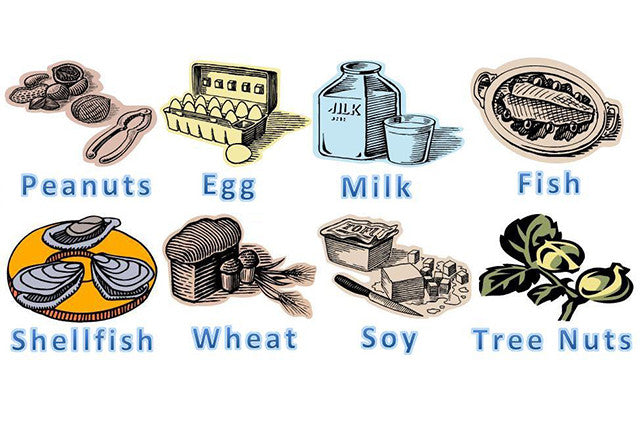Sizing Guide
GUIDE TO MEASURING YOUR WRIST FOR ADJUSTABLE BRACELETS

GUIDE TO MEASURING YOUR WRIST FOR BUCKLED BRACELETS

May 15, 2017

When the body’s immune system responds to proteins in certain foods by attacking them, this is called an allergic reaction. Very little is known as to what can cause a food allergy but theories abound including GMOs or genetically modified crops, the “hygiene hypothesis” that states keeping our household and environment too clean is thought to make our immune system turn on itself, a mother’s diet during pregnancy, and one’s genetics. These are merely theories however, and years of research have not found anything concrete – it seems like it just happens.
In the United States today, researchers estimate that about 15 million people have food allergies. Almost 6 million of them are children below the age of 18. About 30% of children with food allergies are allergic to multiple foods.
Top Allergens
Foods that cause allergic reactions are called allergens. There are 170 foods that have been reported to cause allergic reactions but the following eight account for 90 percent of the allergies in the United States.
With the growing number of children being allergic to sesame, this food is also being pushed to be recognized as a ninth major allergen and be mandatorily disclosed on food labels.
What are the Symptoms?
The symptoms of food allergies may appear within minutes up to 2 hours of ingesting the food a person is allergic to.
The following are typical allergic reactions:
Mild symptoms, when left untreated, can become more severe. Food allergy reactions should not be taken lightly. If not treated immediately, the symptoms can become more serious and lead to anaphylaxis.
Anaphylaxis can lead to:
Once anaphylaxis begins, the only known effective treatment is the drug epinephrine. Epinephrine must be injected immediately (within minutes of the severe symptom appearing) to avoid a fatal reaction. In some situations, more than one dose may be needed.
Anaphylaxis to food results in an estimated 30,000 emergency room visits, 2,000 hospitalizations and 150 deaths a year in the U.S.
When Symptoms Occur
When the symptoms appear after eating a certain food, it is a possible sign of food allergy. Consult a doctor for appropriate testing and evaluation. Once you or your child is found to be allergic to certain food(s), you should:
Who are at Risk?
Kids who have food allergies are 2 to 4 times more likely to have other allergic conditions like eczema or asthma.
Some parents think that delaying the introduction of allergenic foods like peanuts to children or babies with eczema or egg allergy can reduce the risk of their kids having adverse reaction. However, introducing peanuts early on can actually reduce the risk of the child developing an allergic reaction to peanut foods.
Although food allergies mostly develop in adulthood, some 15% of food allergies are first detected in adulthood. This may be due to adults trying out new foods.
Up to 25% of epinephrine administrations in schools involve individuals who were not aware they are allergic at the time of the reaction. More than 15% of children with food allergies have had reactions while in school.
Severe allergic reactions can happen at any age but the most at risk of fatal anaphylaxis are teens and young adults with food allergies. People who are allergic to certain foods and also have asthma are at a higher risk for severe or even fatal allergy reactions. Statistics show that most fatal reactions are triggered by food ingested outside the home.
Will Food Allergy Eventually Go Away?
Some food allergies are outgrown like allergies to wheat, soy, eggs and milk. These allergies start to resolve around the age of 5.
Peanuts, tree nuts, shellfish and fish allergies are generally for life.
There is no known cure for food allergy but it can be managed so the worst can be avoided. The most important course of action is to completely avoid allergens and knowing how to act at the first sign of symptoms.
What the Government is Doing
The FDA enforces the Food Allergen Labeling and Consumer Protection Act of 2004 to help Americans with food allergies avoid the health risks caused by having allergic reactions.
Basically, the Act requires that all FDA-regulated foods be properly labeled if they contain ingredients or protein that come from any of the 8 major food allergens. This will greatly help an individual with food allergies identify and avoid offending foods.
Note: The FDA regulates all foods except some egg products, poultry, most meats and alcoholic beverages which are regulated by other Federal agencies.
The FDA asks the public to report any suspected foodborne illnesses as well as issues with a food product’s labeling and mis-use of ‘gluten free” claims. To make a report, contact MedWatch at 800-332-1088 or go to http://www.fda.gov/MedWatch
Food Allergies and Raising Awareness
 May 14 to 20 is Food Allergy Awareness week. Let us take this opportunity to raise more awareness to this medical condition that affects and potentially endangers so many American adults and children.
May 14 to 20 is Food Allergy Awareness week. Let us take this opportunity to raise more awareness to this medical condition that affects and potentially endangers so many American adults and children.
Raising awareness is important and necessary as this can help spread education, promote safety and improve the lives of the 15 million Americans suffering from food allergies including those who are at risk for anaphylaxis.
Teal is the color for food allergy awareness. This year, create some awareness for food allergy in your family and among friends by wearing a food allergy awareness bracelet that is proudly handmade by a U.S. veteran.
HandmadeByHeroes.com will be donating 1 medical ID bracelet to a child in need for every 10 medical ID bracelets and awareness bracelets sold during food allergy awareness week.
Sources: FoodAllergy.org / FDA.gov

Comments will be approved before showing up.
January 08, 2018
January 01, 2018
November 11, 2017 1 Comment
This section doesn’t currently include any content. Add content to this section using the sidebar.
This section doesn’t currently include any content. Add content to this section using the sidebar.


